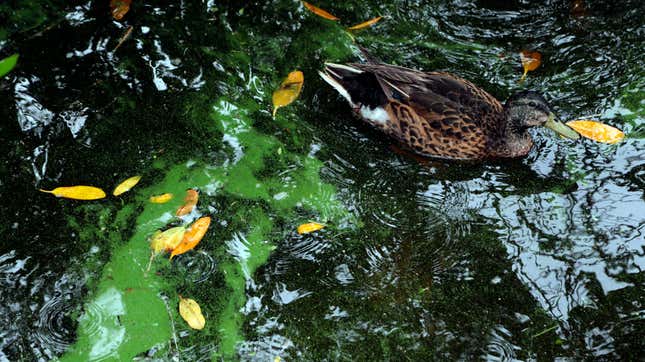
Toxic algae blooms have sent over 300 Americans to the emergency room in recent years, new research from the Centers for Disease Control and Prevention has found. Researchers reviewed ER visits related to algae bloom exposure across the country between 2017 and 2019, and they warn that doctors will need to be on the lookout for these cases, given that blooms are likely to become more common and widespread.
Algae blooms happen when large colonies of algae or plant-like bacteria called blue-green algae rapidly form in salt and freshwater environments. These blooms can turn harmful when they start to pump out massive quantities of toxic byproducts into the surrounding water and air. Algae can produce lots of different toxins with varying effects, but many can affect the organs of exposed wildlife, pets, and humans. Blooms tend to cause distinctive changes to the color of the water’s surface, but not always.
There’s still a lot we don’t know about these blooms, including how often they actually make people sick. So CDC researchers decided to look at de-identified data from the National Syndromic Surveillance Program (NSSP), which collects information on symptoms people are reporting in emergency rooms. These systems ideally act as an early warning signal of emerging diseases or other worrying health trends.
Between January 1, 2017 and December 31, 2019, the team found 321 algae bloom-related ER visits. These visits most often involved respiratory (41%), followed by gastrointestinal (14%) and neurologic (10%) symptoms; some also reported a rash (8%). About a third of visits occurred in the Southeast U.S. Algae blooms are more likely to occur in warmer months, and ER visits went up around those months, too.
The study was published last week in the CDC’s Morbidity and Mortality Weekly Report.
The authors say that ER data can be used to “identify the extent of illness from harmful algal bloom exposure in the United States.” But they caution there are some limitations. The NSSP only covers 70% of the country’s ERs, for one. And for about two-thirds of the cases identified, they had to rely on written text about the symptoms, not a formal diagnosis related to bloom exposure. They also spotted a few reports where a diagnostic code did indicate bloom exposure, but the listed symptoms were likely unrelated.
Still, the results show that algae blooms aren’t just a problem for wildlife and unlucky pets. In 2018, the authors noted, the U.S. had a relatively large spike in ER visits, right around the time a red tide algae bloom occurred in the Gulf of Mexico. And it’s likely that these blooms will become more of a nuisance in the future. The researchers point to evidence suggesting that warmer temperatures over time will make blooms more common and happen in places where they previously hadn’t (runoff from industry and agricultural factories also fuel the problem by providing algae with ample nutrients).
“As the frequency and geographic extent of harmful algal blooms increase, it is important for health care providers to discuss and document harmful algal bloom exposures and health effects during medical visits to ensure proper patient treatment and help patients understand how to prevent exposure in the future,” the authors wrote.
In August, a family of three and their dog hiking in California died mysteriously. The investigation is still ongoing, but algae bloom exposure is one suspected culprit. Over the weekend, officials reported the presence of algae toxins in a river near where the family was found; they continue to advise that people and their pets stay away from the water there.